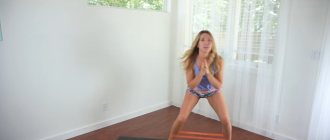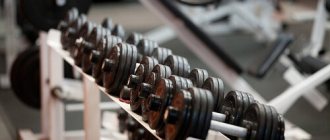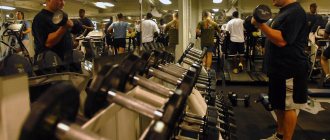Training once a week Full body
It's not possible to do workouts 3 times a week, no problem! If you correctly create a program for a single workout per week, then it is quite possible to achieve good results, both in terms of gaining muscle mass and reducing overall weight.
There is no opportunity to visit the fitness club , no problem! You can also effectively train at home once a week by creating a high-quality full body training program. Of course you won't reach Mr. Olympia,
but it is quite possible to gain the physiological norm of muscle mass, even with some advantage.
The main thing is to create the right individual training plan and follow it!
What is the best training frequency?
You already understand that all strategies are effective, and you are wondering whether one of the options will be better or worse than the other. Yes! Choosing the best strategy depends on individual factors, especially your skill level. That's what it means.
Beginners. If you are new to strength training (that is, you have been training regularly and properly for less than 6-8 months), all the research, expert recommendations and practical experience suggest that 3 workouts per week is ideal for you. The example given split (3 workouts for the whole body) is the optimal choice recommended for all beginners.
Intermediate and advanced level. For anyone who has passed the beginner stage (that is, has been training regularly and competently for more than 6-8 months), research, expert advice and practical experience agree that a frequency of two workouts per week is ideal.
The example of the split given earlier (2 workouts each for the upper and lower body) will be the optimal choice. This is the strategy most often recommended by the most educated people in the iron world.
But what about 1 workout per week?
Although training each muscle group once a week is most popular among average gym goers, it also turns out to be the least effective for most. Is the strategy working? Without a doubt (provided you do everything right). Is it the best for most of us? Absolutely not.
A whole week of rest between training a specific muscle group is a serious waste of time, no matter how it is served. Judge for yourself. The muscle receives 52 training sessions per year.
If you train her 2 times a week, she gets 104 training sessions per year. What strategy do you think will give the best results in the future over the same period of time? The answer is obvious, isn't it?
If so, why is the option of one muscle group workout per week so popular? Because it is great for people who use various "support" (i.e. pharmacology and steroids), people with excellent genes and bodybuilders who have already almost fully realized their muscular potential.
All these people look amazing. We want to be like them and try to imitate them. The only problem is that we are average, normal people training without “support”, and such a strategy will be less effective over the long term. Scientific research and real-life examples prove this.
Who is suitable for ultra-abbreviated muscle training?
First of all, the regime of one workout once a week is suitable for high gainers and ectomorphs. Considering that they need more time to restore the normal functioning of all body systems, but at the same time, prolonged training is not required to pump up the muscles. With one targeted workout per week, muscle growth will be at an average rate.
Hardgainer (from the English hard - “heavy” and the English gain - “increase”) A person who is not genetically predisposed to gaining muscle mass and increasing strength.
Also suitable for those who are in fat reduction mode. Of course, subject to an individual nutrition schedule and one toning and one cardio workout.
But does it make sense
The question often worries us: is there any point in such loads or is it better not to train at all? Much depends on the initial indicators. If a person previously did not have an athletic physique and decided to become a bodybuilder in a short time, then such a technique will not help him in this.
To a greater extent, it is intended for those who previously “disappeared” in the gym and trained “by the sweat of their brow”, and now want to consolidate the results obtained and increase them.
! If you give up strength training completely, your form will go away, and visiting the rocking chair once a week will help avoid this.
So is there any point in doing things like this:
- By maintaining the proper amount of exercise, it will be possible to maintain the achieved result and even increase it, but the last rule applies only to young athletes.
- If a person has reached a certain age, as well as fitness, then to maintain it, conducting classes once every 7 days will not be enough. It is recommended to visit the hall more often.
Training once a week, does it make sense?
One workout per week makes sense if it is targeted and balanced. And each workout should be a logical component of a single training plan, drawn up for at least three months .
Benefits of doing one workout per week:
- the muscles have enough time to fully recover and develop;
- It’s good to work out a nutrition schedule, especially if the goal is recomposition of body composition, i.e. simultaneously burn fat and gain muscle mass;
- no danger of overtraining;
- The central nervous system and other body systems are not overworked;
- If it’s a day off, you can take your time and allocate enough time for training to perform all approaches and repetitions well.
The effectiveness of basic training can also be increased by conducting one tonic workout.
A very important advantage of performing one workout per week in the first half of the day off (10-13 hours): the muscles that hold the spine are in good working condition, like other stabilizer muscles. Good long-term work of the main working muscles depends on this, but most importantly safety, which is ensured by the internal muscles. If you carry out basic training in the evening, after work, tired joint ligaments and muscles that hold the spine can fail, which is fraught with serious injuries to the spinal column (vertebral displacement, protrusion, hernia), as well as joints, especially the legs.
At the end of the working day, the central nervous system is also not in the best shape, which can significantly negatively affect the process of controlling muscle activity. And as a result, a decrease in quality, productivity and effect.
Workout once a week Full body to build muscle mass
Considering that in one Full body workout it is necessary to give a full load to all muscles, it will be “heavy” for all body systems. Take sufficiently long breaks between approaches, the time necessary to restore the performance of the muscles and central nervous system.
Three basic exercises for Full body:
- Deadlift - back extensors, glutes, hamstrings, core muscles;
- Wide grip pull-ups - lats, biceps, rear deltoids, trapezius;
- Bench press - pecs, front deltoids, triceps.
Depending on your main goal, we add strengthening exercises to them.
If legs, then - Squats with a barbell - thighs, calves, buttocks, longitudinal backs, core.
Back - Bent-over barbell row to the chin with a wide grip (lats, middle and rear deltoids, arms, shoulders). On the back and core, you can add pull-ups, with access to the horizon.
Shoulders - military press.
But more than eight exercises are hardly worth doing. For most, the optimal option is 5, the maximum is 6.
Power training
If you prefer to exercise at a relaxed pace and pace, then these workouts are for you.
To get your body in shape and lose weight, you must first identify your problem areas. For every girl, these are their places. For some it is the stomach and sides, for others it is the hips and buttocks. Once you have done this, then you need to start from here.
Let's look at it with an example.
If you have a problem area of the buttocks and thighs, and you really want to change their shape, size, outline, etc., then naturally, you should focus your training on the muscles of the legs and buttocks.
Your workout structure might look like this:
- Warm up . Warm-up is a mandatory component before any workout, absolutely any! You should devote 3-8 minutes to warm-up and joint exercises.
- Next, you choose any workout for legs and buttocks that I have on my channel, and perform it according to my recommendations that I give. I usually say how many sets or circles to do a given workout. If I don’t mention the number of repetitions, then you just do the first round with me, and then rewind to the beginning of the video and do the second round again with me, without bothering about repetitions, I’ve already taken care of that, so you don’t even have to no need to count. And so on, depending on how many circles you need to do for this workout.
- When you have completed your workout, I recommend doing a few minutes of cardio . This is necessary in order for the fat burning process to start, since during strength training (its main part) we mainly influence our muscle fibers, making them denser, stronger, more resilient, creating beautiful shapes and relief, but as such there is no fat burning process is happening. In order for it to turn on, you need to do cardio.
The cardio time ranges from 15 to 30 minutes, depending on how long the main part of your workout took you and what kind of physical fitness you have. But I don’t recommend practicing for less than 15 minutes. There will simply be no effect.
- And after cardio, the last stage of training remains - stretching . Stretching is also a mandatory component of any workout. It allows you to restore your heart rate, breathing and return your muscles to their pre-workout state.
And yet such a moment. If you have time, then before cardio, after all the circles on your legs and buttocks, you can do another short abdominal workout . If you include abdominal exercises after the main leg workout, then it is enough to spend 10 minutes working on it, and then start cardio.
If you have a problem area - the stomach, then you can do a full abdominal workout for 20-30 minutes, and still do cardio after it.
This applies to strength training in a calm mode. The same applies to training the arms, chest and back, or training all muscle groups at once (there are few such training, but they still exist). The whole sequence remains the same.
Now let's figure out how many times a week you need to do strength training according to this principle.
Workout once a week Full body sets, repetitions
The number of approaches is from 2 to 6-8, optimally -5, for each exercise. The number of repetitions can vary significantly depending on the goal and load, 1 repetition using the maximum load, an even number in approaches from 3-5, several options for gaining muscle mass 6-8, 8-12, for developing endurance 15-20, and also an increasing pyramid with increasing weight, and a decreasing pyramid with decreasing load weight.
The main factor in muscle hypertrophy is a systematic increase in load! This principle is important for all options, both in the number of approaches and repetitions. But the load should increase taking into account the supercompensation schedule.
KRD 1,2 - growth curves of achievements of a new sports form.
Training once a week Full body warm up - cool down
As a warm-up, we perform multi-joint exercises on the target muscles, but without load. Cool down - stretching the target muscles, possibly a small cardio load. The duration of each is 7-12 minutes.
Are you doing HIIT correctly?
High-intensity interval training is a training method in which short periods of high intensity are followed by calmer activity or rest.
The ratio of work and rest during training can be different: 1:1 (for example, sprint for 30 seconds and 30 seconds rest), 1:2 (sprint for 30 seconds and a minute rest), 1:3 (sprint for 30 seconds and one and a half minutes of rest) and so on. The main thing is to work at your maximum.
After real HIIT, you should be left feeling completely exhausted. If you can continue the workout even a few seconds longer than expected, or repeat the HIIT session the next day, then you haven't given it your all and it's not a true high-intensity workout.
Many people who choose to do high-intensity workouts don't push themselves as hard as they need to to get the full benefits of HIIT. It is difficult to force yourself to train at the peak of your capabilities, because it is very uncomfortable: you are out of breath, sweat flows in streams, and your muscles become clogged.
But then why do high-intensity interval training at all? Isn't it better to replace it with calm cardio or moderate strength training? In fact, for certain purposes, HIIT is simply irreplaceable.
Full body training program once a week at home
It is not necessary to sign up for a fitness club to lose weight and build muscle mass. A full workout can be organized at home. However, you don’t have to have a barbell at home! Dumbbells, kettlebells, horizontal bar, TRX and resistance band.
The best horizontal bar for home
can provide an acceptable load for gaining muscle mass.
CHRIS HERIA deadlift
The main issue is the deadlift and squats. These exercises will have to be broken down into components.
And choose the types of exercises that can provide the greatest load. For example, King's deadlift.
Efficiency increases significantly if you use the mental-muscular connection to engage the target muscle.
Training once a week Full body and toning training
Toning training should act as an additional stimulation for the muscle building process. It is better to do a toning workout 2-4 days after the main one. Those. if the developmental training was on Saturday, then the toning training should be carried out from Tuesday to Thursday. It is advisable to follow this schedule from week to week.
Toning training should fit organically into your personal supercompensation schedule, through which it is desirable to reach overcompensation.
Toning workout for building muscle mass
When building muscle mass, it is very important to feel that the muscles are ready to bear the new load without damage. Based on this, choose a day during the week. A toning workout can be done at home by working the target muscles with the required load.
The composition of the exercises of the toning workout generally repeats the basic one, because the target muscles are the same. But there should be no more than two approaches, and the load is adjusted according to how you feel. But, at least 30% of the MP.
In addition to the main exercises, it is advisable to include 2-3 exercises for the core muscles. Including the plank, but a power version.
TRX hinged bar
And also “Prayer”,
and lifting the legs while hanging on the “lower press Belt of Adonis-Apollo”
It is helpful to include semi-strength isotonic exercises for core strengthening and full-body stretching.
Targeted exercises are possible on the shoulders, to expand the shoulder girdle, and middle deltoids.
Middle delta
Toning workout for weight loss
In this case, the toning workout should be more active in terms of calorie burning. With the same basic exercises, core work needs to be done more actively, for example with Burpees,
and the “plyometric jackknife.” The workout can also be done at home, working the target muscles with the required load.
Full body and running
It would be a good idea to complement your Full body with a toning workout in the form of running. Running will not only help increase the activation of all body systems and improve muscle tone. But running can also contribute to the accumulation of muscle mass.
Interval running for both muscle mass and weight loss
The effectiveness of the process of gaining muscle mass is much higher if you use interval running.









